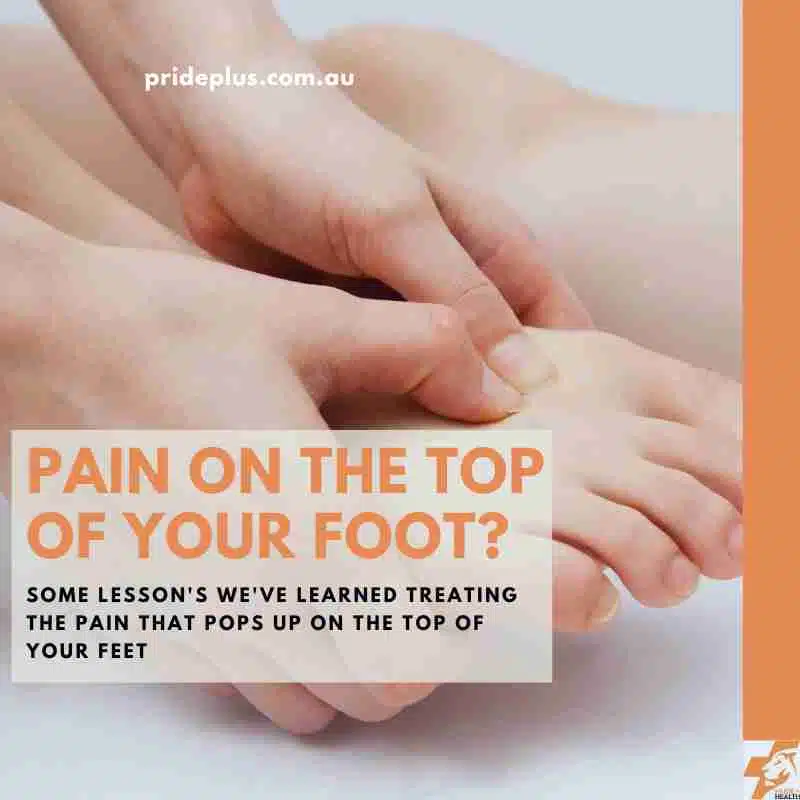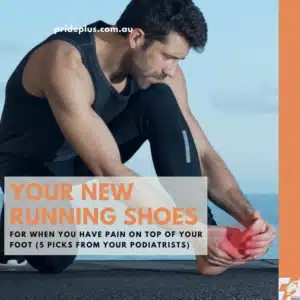I used to think treating pain on the top of the foot was hard. Turns out I was just making some simple mistakes.
If you have pain on the top of the foot start with your podiatry session. Book online or call us.
Early in my podiatry career I developed a bias for getting great results for those coming to see me with sore heels and sore toes. The bread and butter of musculoskeletal podiatry. Plantar fasciitis and bunions. I’d seen hundreds of cases of sore heels and toes and started to think I was pretty good at helping these clients get better.
Hubris – never hurt anyone did it?
So when someone came in looking for help with the pain on top of the foot I used to start sweating. It’s not as common as heel pain. My tricks for strapping and exercises for arch pain were not going to work for me here.
And honestly, they shouldn’t work either.
Quality podiatry care involves working with you to determine exactly what you need for your pain. Not what worked for someone else’s sore feet last week.
So back to the drawing board I went. And here’s what I was able to learn and apply. Refined over the years of podiatry practice.
Pain on top of the foot could be caused by so many different things – so get your diagnosis correct
Forgive me if this sounds a little basic, but you need to know what you’re treating to get it better.
A clear, accurate diagnosis from your podiatrist is a must before you can start treating the pain on top of the foot.
While morning heel pain is almost always plantar fasciitis (ok – it can be one of about 6 things but it’s very easy for you to work out which one it is) – pain on top of the foot is a little more complex.
It’s often a combination of things.There’s a multitude of bones and joints that make up the top of your foot. Add in your long extensor tendons and a couple of nerves close to the skin and all of a sudden there’s levels of complexity there.
So starting your journey to successfully treat your pain on top of the foot involves getting a clear diagnosis from your podiatrist. By not getting this diagnosis correct you run the risk of wasting time and dollars on therapies that are not going to be helping you get better and enjoy life again.
Let’s go through three things together which you can do to get on top of your pain on the top of your foot..
#1. Visit a great podiatrist
Hey, you’re the one with the painful foot. If you want to get the pain on top of your foot better start with the experts.
Our team of PridePlus Health podiatrists have spent years studying both at University and with our ongoing education in our clinics. Book in now with any one of our podiatrists near you and you can complete step one and move onto step two.
#2. Commit to change
No matter the cause of the pain on the top of the foot – something is going to need to change for you to get better.
If your foot pain relates to the bones, joints and tendons across the top of your foot then change will likely involve exercises, shoes and orthotics.
Exercises that strengthen, lengthen and mobilise your foot and ankle can help by increasing the capacity of your foot to carry you around as well as de-escalate your pain system.
Your shoes can either increase or decrease the work done on top of your foot. Sometimes it’s as simple as going to lower drop shoes. Athletic shoes with large heel to toe drops can decrease the work done at the heel, but increases it and can cause pain on the top of the foot.
An example of this change is to move from a large drop shoes like an Asics Kayano (10mm) and go for a lower drop Asics Glideride (5mm).
Orthotics or insoles can push up under the foot to reduce the pulling on the top of your foot. This can be very useful for those who struggle to complete exercises due to too much pain in the acute stage of an injury.
#3. Celebrate your wins along the way
Pain on top of the foot isn’t going to get better straight away. Celebrate your wins as you go to keep you on track.
With most painful musculoskeletal complaints of the foot and ankle there’s some time that needs to pass as you continue to treat your feet. Exercises that build strength take time. Recovery takes time. Healing takes time.
With foot pain there’s that constant reminder that there’s a problem too. Your feet interrupt you with messages of pain so many times during the day:
- Taking out the washing, ouch.
- Running for the tram, ouch.
- Lacing up your runners to go out for a jog. Ouch again.
So as you’re recovering from your pain on top of the foot you’ll have some wins along your journey that you need to celebrate.
- That first time you’re able to wear that pair of shoes again.
- When you’re able to complete your favourite running track circuit.
- Or maybe it’s when you first can do a full set of exercises on your feet.
Whatever milestones are on your path back to living your best life on your feet celebrate them. Recognise the work you’ve put in to get there. You’ve earned that success.
You’ll find it much easier to build those strong habits that you’ll need to overcome the pain on the top of your foot and then stop it from coming back too.
Frequently asked questions about pain on the top of the foot
These are the questions we here in clinic about all the different types of pain on the top of the foot.
What causes top of the foot pain?
The causes of pain on the top of the foot are usually always an overload of some sort. The tricky part is working out just what is overworked, and why.
As there’s a variety of bones, joints and tendons that make up the top of the foot it can be a number of different specific diagnoses that leads to your midfoot being sore.
For example, midfoot osteoarthritis is a very common cause of pain in the top of the foot. The exact joints that are affected by arthritis can vary from person to person, and the exact cause of that arthritis can vary too.
Triggers that can lead to more pain on top of the foot are simple things like lacing your shoes up too tight or wearing high-heeled shoes to the more complex like decreased strength through the shin (tibialis) muscle groups.
How is pain on top of the foot diagnosed?
Your podiatrist will start by asking your a series of structured interview like questions to take a thorough history of your sore feet and your lifestyle. From there a physical examination and gait assessment will start to show some clues to what the problem is.
Sometimes there is a need for medical imaging to help find out about the pain on the top of your foot. Plain film X-rays can show osteoarthritis like changes, bone spurs or bone cysts. Ultrasound imaging can indicate if the tendons on the top of the foot known as the extensor tendons are involved.
There are extreme cases where more in depth imaging such as an MRI might be indicated if you and your podiatrist needs a deeper look into the structures of your feet. But these are in the minority.
Most of the time you and your podiatrist will be able to diagnose the cause of the pain on the top of your feet in the clinic and establish a clear plan with actions to get you back on track.
What are the best shoes for pain on the top of the foot?
The best shoes for you and your pain might not be the best shoes for me. It’s quite personal.
In saying that, there are some features to look for in shoes that decrease the amount of stress on the top of your foot.
- Lower heel: Aim to wear shoes that have a lower heel which includes shoes like runners and what you have on in and around the house.
- Comfortable fixation: Your laces and straps should hold onto your foot but not too tight.
- Stable sole: If you can pick up your shoes and bend the sole in circles it’s probably not supportive enough to help you with the pain on the top of your foot.
What are the best exercises for pain on the top of the foot?
Similar to getting the right shoes, the best exercises for pain on the top of the foot varies from person to person.
Building up strength through the muscles and tendons that support the midfoot is crucial for many sufferers of midfoot or top of the foot pain.
Calf raises to strength the tibialis posterior muscle and toe raises to strength tibialis anterior are a great start when prescribed as part of a thorough plan.
Do I need orthotics for midfoot pain?
Orthotics are often used by podiatrists to provide a nudge under your foot when your muscles don’t have enough grunt to pull and stabilise your foot.
Whether you need orthotics for the pain on the top of your foot is the perfect question to ask your podiatrist as they’ll be able to give you the exact answer. If you do need them, our podiatry team will stand by you and your orthotics with your Orthotic Guarantee. If you don’t need them you’ll have a clear plan of what you do need to do outside of orthotic therapy.
What are the most common diagnoses for pain in the top of the foot?
The diagnosis for pain in the top of the foot can be any (and often a combination) of the following:
- Acute on chronic midfoot osteoarthritis, known as synovitis or capsulitis
- Can involve a bone spur known as an osteophyte too
- Extensor tendinopathy (extensor tendonitis or enthesopathy)
- Tibialis anterior tendinopathy
- Tibialis posterior tendinopathy
- Extensor hallucis longus tendinopathy
- Extensor digitorum longus tendinopathy
- Stress fractures
- Metatarsal stress fractures
- Navicular stress fracture
- Cunieform stress fractures
- Dorsal nerve compression
- Intermetatarsal nerve compression
- Morton’s Neuroma
- Bursitis
What’s nearly as important as that diagnosis is the why. In your session with your podiatrist you’ll identify your diagnosis, your why and then what you can change together to achieve your goals.
About the Author

Podiatrist Tim Mulholland has learned his lesson. He thought he could treat every foot the same and they’d magically get better. He was not correct. Start with these principles to help with the pain on the top of your foot and you’ll be on the way to having the success that eluded Tim in his early days as a podiatrist.




